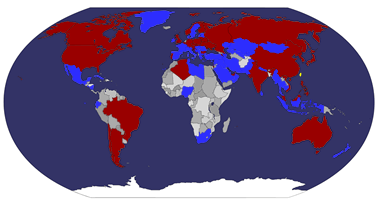The Solovetsky Islands/Îles Solovki
The Solovetsky Islands (Russian: Солове́цкие острова́, Соловки́) are located in the Onega Bay of the White Sea, Russia. The islands are administrated from Arkhangelsk as Solovetsky District and are served by the Solovki Airport. Area: 347 km². Population: 968 (2002 Census); 1,317 (1989 Census).
Geography
This archipelago consists of six islands known collectively as the Solovki:
Bolshoy Solovetsky Island – 246 km².
Anzersky Island (Anzer) – 47 km².
Bolshaya Muksalma – 17 km².
Malaya Muksalma – 0,57 km².
Bolshoy Zayatsky – 1,25 km².
Maly Zayatsky – 1,02 km².
The shores of the islands are very indented. They are formed of granites and gneiss. The relief of the islands is hilly (the highest point is 107 m). Most of the Solovetsky Islands are covered with Scots Pine and Norway Spruce forests, which are partially swampy. There are numerous lakes, which were joined by monks so as to form a network of canals.
One interesting feature of these islands is stone labyrinths and other stone settings, especially the Stone labyrinths of Bolshoi Zayatsky Island. Such labyrinths were typical for Northern Europe, but most have perished and now Solovetsky Islands have some of the best remaining examples.
Monastery
Historically the islands have been the setting of the famous Russian Orthodox Solovetsky Monastery complex. It was founded in the second quarter of the 15th century by two monks from the Kirillo-Belozersky Monastery. By the end of the 16th century, the abbey had emerged as one of the wealthiest landowners and most influential religious centres in Russia.
The existing stronghold and its major churches were erected in stone during the early reign of Ivan the Terrible at the behest of St. Philip of Moscow. At the onset of the Schism of the Russian Church, the monks staunchly stuck to the faith of their fathers and expelled the tsar's representatives from the Solovki, precipitating the eight-year-long siege of the islands by the forces of Tsar Alexis.
"Bombardment of the Solovetsky Monastery by the Royal Navy during the Crimean War". A lubok (popular print) from 1868.
Throughout the imperial period of Russian history, the monastery was renowned as a strong fortress which repelled foreign attacks during the Livonian War (16th century), Time of Troubles (17th century), the Crimean War (19th century), and the Russian Civil War (20th century).
Labor camp
After the October Revolution, the islands attained some notoriety as the site of the first Soviet prison camp. The camp was inaugurated as a "detention camp" in 1921, while Lenin was still at the helm of Soviet Russia. It was transformed into a prison in 1929 and was closed ten years later, on the eve of the World War II. The Soviet government realised the islands' strategic importance, and by the beginning of the war, there was a naval base of the Soviet Northern Fleet.
In 1974, the Solovetsky Islands were designated a historical and architectural museum and a natural reserve of the USSR. In 1992, they were inscribed on the World Heritage List "as an outstanding example of a monastic settlement in the inhospitable environment of northern Europe which admirably illustrates the faith, tenacity, and enterprise of later medieval religious communities".Today, the Solovki are seen as a major tourist magnet in the orbit of the Russian North. One can get to the islands either by ship from Kem or by plane from Arkhangelsk.
Les Îles Solovetski (en russe : Солове́цкие острова́), connues également sous les noms de Solovki ou Solovetsk, forment un archipel au nord-ouest de la Russie dans la mer Blanche. Situées dans la baie d'Onega, les îles sont administrées par l'oblast d'Arkhangelsk. Leur superficie totale est de 347 km2 pour une population de 968 habitants en 2002. L'archipel comprend six îles dont les plus grandes sont Solovetski, Anzerski, Bolchaïa Mouksalma et Malaïa Mouksalma). Il est célèbre pour le monastère de Solovetski du XVe siècle et son ancien camp de travail soviétique, précurseur de l'organisation du Goulag. En 1974, les îles devinrent une réserve naturelle protégée : l'archipel, son patrimoine architectural comme son histoire qui en fait un lieu de mémoire privilégié de la Terreur stalinienne, furent l'un des premiers sites russes à être inscrits sur la liste du patrimoine mondial de l'UNESCO en 1992.










.jpg)























 taiwan
taiwan  cover or postcard
cover or postcard  FDC
FDC 






























































































No comments:
Post a Comment